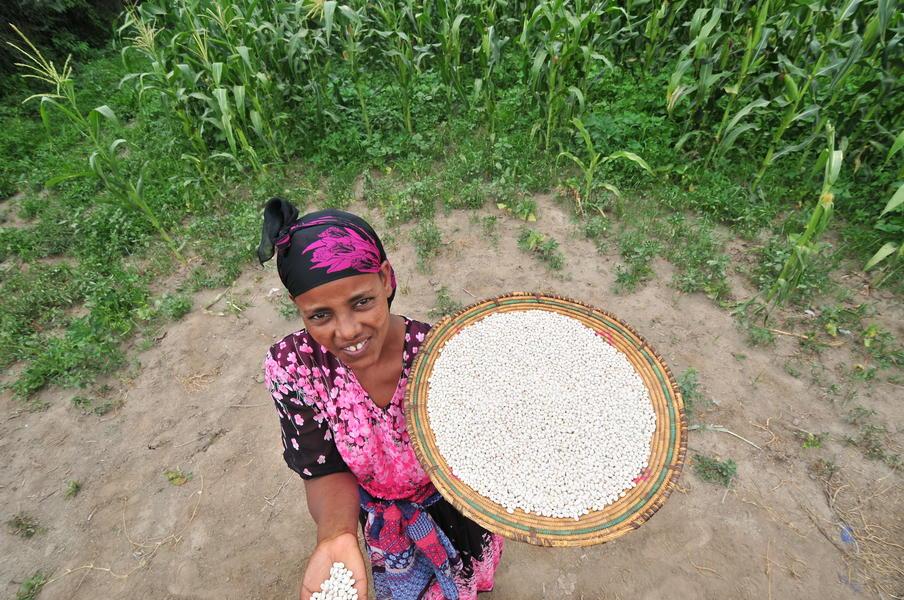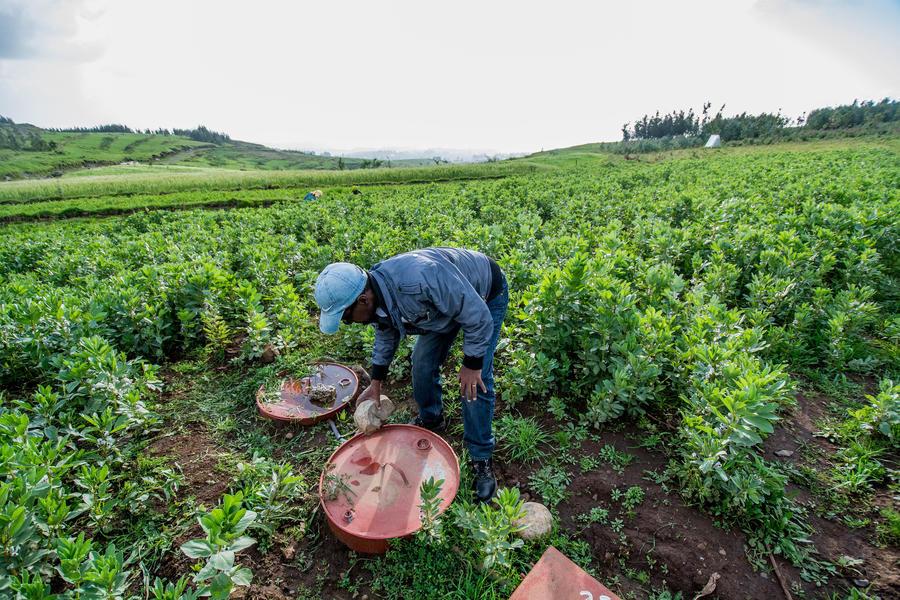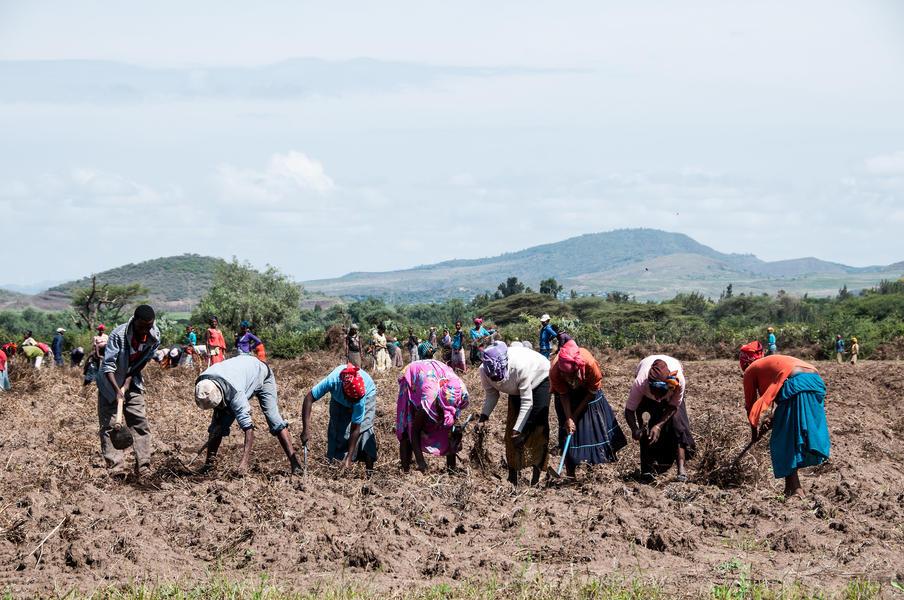PROJECTS AND FLAGSHIP INITIATIVES IN ETHIOPIA

We contribute to Ethiopia’s agricultural and food systems transformation agenda through multiple approaches such as use of genetic resources, crop improvement, applying improved agronomic and management practices, contributing to optimal fertilizer use, and leading the effort to build ‘digital agriculture’ through ’big data’ analytics, developing an investment roadmap for integrated climate and weather services into agricultural risk management, increasing the skills of food systems actors through capacity building and updated decision-making tools.
Our projects also focus on the empowerment of women in food systems by mainstreaming gender and social inclusion across all Alliance initiatives in the country.
Seeds for Needs:
The Seeds for Needs project in Ethiopia has reshaped plant variety evaluation and selection, focusing on farmers’ needs. Farmers in Ethiopia’s major farming regions are increasingly using crowdsourcing for quick crop variety selection, based on their individual priorities. Hundreds of crop varieties have now been selected and up-scaled using the Seeds for Needs approach.
Ethiopia has a wealth of plant genetic resources, and the Seeds for Needs project aims to evaluate the potential of available genetic resources to increase resilience in the face of climate; one good example for this has been Seeds for Needs development of durum wheat genetic resources development in Ethiopia.
Climate Change Action
Agriculture accounts for more than half of Ethiopia's GDP, with more than 50% of the country’s population employed primarily in subsistence rain-fed farming, and livestock production. Most of the population employed in agriculture are smallholder farmers working on less than one hectare of land, where increasing climate extremes have immediate and long-term impacts on their livelihoods.
In recent years, the increasing frequency of adverse weather conditions has negatively affected poor and vulnerable communities, contributing to significant risks of food insecurity as well as economic inequality and internal and external migration. Therefore, providing weather and climate services (WCS) for farmers is key to anticipating and preparing for climate risks. Sustainable and innovative financial mechanisms are also essential in accelerating climate-smart agriculture among farmers, increasing their production and income whilst improving their resilience to climate shocks and reducing GHG emissions from their production.
Improving water access is essential for pastoralists to manage drought risks. Pastoral communities migrate long distances in search of forage and water, due to a lack of knowledge of where to find resources. Due to a lack of funding, even NGOs and local government agencies rely on outdated knowledge and information gathered from regional surveys for planning. Recognizing the importance of climate change on the country’s development, the Ethiopian government developed a Ten-year Development Plan (2021-2030), to increase the incomes of farmers and end poverty by making agriculture more productive and competitive.
To support the country’s agricultural projects, the Alliance’s Climate Action research area focuses on the following priorities:
-
Map and integrate WCS into agricultural risk management (ARM) and identify investable solutions that strengthen large-scale ARM tools by engaging the government and private sector,
-
Support the government in building partnerships across the country to unlock private and public sustainable investments, and,
-
Increase the climate resilience of pastoral communities in Ethiopia through provision of resource identification information for resilient decision-making.
Integrating Weather and Climate Analytics into Agricultural Risk Management (Clim-ARM)
The Integrating Weather and Climate Analytics into Agricultural Risk Management (Clim-ARM) project is funded by the Bill and Melinda Gates Foundation (BMGF) and implemented with local partners in Rwanda and Ethiopia. In Ethiopia, the project is led by the Alliance of Bioversity International and CIAT, in partnership with the Agricultural Transformation Institute (ATI), Ethiopian Agricultural Research Institute (EIAR), Mercy Corps, as well as key national and regional stakeholders in the agricultural value chain.
The Clim-ARM project deploys scientific and technological advances to link hazard predictions with actionable management strategies that address risks in agricultural value chains. Building on previous analyses and methods, Clim-ARM ensures gender-responsive and socially inclusive pathways for scaling and mainstreaming selected ARM tools and to develop high-impact investments in agricultural risk management.
Capacity development is one of the key focus areas of the Clim-ARM project, working with key private and public-sector institutions in adopting effective climate-smart ARM tools and prioritizing risks. Additionally, the Clim-ARM project has developed a country-level ‘private sector landscape’ to identify opportunities for upscaling through investment.

White pea bean varieties developed by researchers eight years ago at the Ethiopian Institute of Agricultural Research (EIAR) and Alliance of Bioversity International and CIAT are more drought-resilient, pest-resilient, and disease-resilient than previous varieties.
©Alliance of Bioversity International and CIAT/Georgina Smith

Entrepreneurial farmers in Ethiopia restored their land eight years ago through water harvesting, check dams, and a range of other water harvesting methods through the Africa Rising project with ILRI and other CGIAR partners.
©Alliance of Bioversity International and CIAT/Georgina Smith

Farmers planting drought-resilient, pest-resilient, and disease-resilient white pea bean varieties developed by researchers eight years ago at the Ethiopian Institute of Agricultural Research (EIAR) and Alliance of Bioversity International and CIAT.
©Alliance of Bioversity International and CIAT/Georgina Smith
Livestock Water Source Monitoring and Risk Management System in Ethiopia
The project mobilizes partners to enable millions of pastoralists to access updated spatial and temporal water availability information. The project is also designed to implement in collaboration with local partners and communities, thus building capacity and sharing knowledge.
The project development used human-centered design (HCD), ensuring its activities are based on a solid understanding of local and national needs related to livestock water management by gathering first-hand insights from end-users (including pastoralists and decision-makers) prior to project development.
A Livestock Information System Roadmap for Ethiopia (aLIVE)
Ethiopia has the largest livestock population in Africa, making sustainable pastoralism an essential component of the country’s economic growth whilst increasing food security and eradicating poverty. However, a lack of relevant data and analytical capacity prevents policymakers from effectively planning, implementing and monitoring livestock management strategies.
The Alliance of Bioversity International and CIAT – with funding from the Bill & Melinda Gates Foundation (BMGF), and in partnership with Ethiopia’s Ministry of Agriculture and Livestock Investment Corporation – developed the National Livestock Information System Roadmap, providing strategic steps for the Ministry of Agriculture to developing a custom-designed, state-of-the-art system (Future-LIS) to deliver more value to stakeholders.
This four-year project involved an analysis of the livestock ecosystem, outlining stakeholder needs, and identifying existing livestock databases, thus enabling project partners to identify challenges and opportunities to develop livestock information systems. The resulting roadmap will provide policymakers with timely and reliable evidence to increase the profitability and sustainability of the livestock sector.
Climate-Smart Agriculture Investment Plan (CSAIP)
Due to increasing climate change variability in Ethiopia, the Alliance worked with Ethiopia’s Ministry of Agriculture to develop the Climate-Smart Agriculture Investment Plan (CSAIP), presenting a strategy for agricultural development funding. The CSAIP was financially supported by the World Bank Group through the Accelerating Impact of CGIAR Climate Research for Africa (AICCRA) program. The plan identifies, evaluates, and prioritizes the most appropriate climate-smart agriculture (CSA) investments in Ethiopia, elaborated in collaboration with key stakeholders. The CSAIP produces an investment portfolio that is supported nationally, to maximize investment opportunities from private sector actors, state institutions, foreign donors, and other stakeholders that focus on agricultural reform. This CSAIP draws from Ethiopia's Nationally Determined Contribution (its commitments to emissions reduction for the achievement of the UN Paris Agreement on climate change), as well as Ethiopia’s pre-existing national policies, and the work of various local, national, regional, and international agencies. The CSA investments were identified through an analysis of Ethiopia’s policies and ambitions, the current state of the agricultural sector, and an analysis of climate change scenarios and its potential impacts on farming.
Ethiopia’s Climate-Smart Agriculture Investment Plan identifies seven priority investment areas, focused on increasing agricultural productivity, enabling farmers to adapt to climate change, and reducing greenhouse gas emissions. These include:
-
improving livestock value chain efficiency,
-
improving the production and utilization of livestock forages,
-
promoting efficient small-scale irrigation,
-
optimize crop production with integrated soil fertility management,
-
strengthening agricultural knowledge through digital advisory services,
-
upscaling improved animal breeding and health management, and
-
promoting improved wheat varieties and CSA practices in wheat production.
The next phase of the project will focus on upscaling CSA innovations in collaboration with Ethiopia’s Ministry of Agriculture, the Agricultural Transformation Institute, and private sector partners. This requires presenting projects that are appropriate for financial investment by private-sector actors, public institutions, bilateral and multilateral financial institutions, and international donors.
